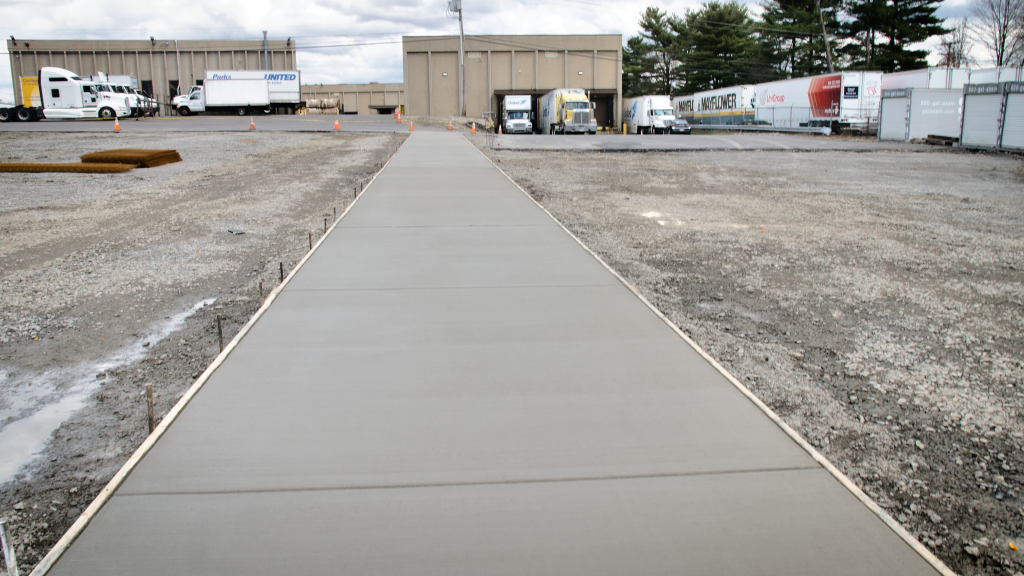Every industrial pavement must handle pressure. Heavy trucks, machinery, and constant movement demand strong, well-designed surfaces. But how do engineers make sure pavements can bear all that weight? That’s where load-bearing requirements for industrial pavements come in.
Understanding these requirements keeps roads, warehouses, and industrial yards safe and efficient. Proper pavement design prevents early damage, reduces repair costs, and improves long-term durability. Let’s break down how load-bearing capacity works and why it matters for every industrial surface.
What Are Load-Bearing Requirements?
Load-bearing requirements define how much weight a pavement can safely support without failing. They depend on material strength, base layers, and expected traffic. Engineers use soil tests and load simulations to determine these limits.
In industrial areas, pavements face different challenges than regular streets. Forklifts, semis, and cargo loaders apply higher stress. That’s why industrial pavements need stronger bases and thicker layers.
Why Load-Bearing Strength Matters
If pavement isn’t designed for its load, cracks, rutting, or surface deformation appear quickly. These problems lead to safety risks and expensive repairs. A strong pavement means smoother operations, less downtime, and fewer maintenance costs.
Think of it like building a foundation for a house. The stronger the base, the longer everything above it lasts. The same logic applies to industrial pavements.
Factors That Affect Load-Bearing Capacity
Several key factors determine how much weight pavement can handle:
- Subgrade Strength: The soil beneath the pavement must be compacted and stable. Weak soil reduces pavement strength.
- Material Type: Asphalt, concrete, and interlocking pavers each perform differently under pressure.
- Thickness: Thicker layers distribute weight more evenly and reduce strain.
- Traffic Type: Frequent heavy loads require higher design standards.
Each element works together to create a pavement that resists fatigue and performs well under stress.
Understanding Pavement Layers
Industrial pavements usually have multiple layers working as one system:
- Subgrade: The natural soil prepared to support layers above.
- Subbase: Crushed stone that spreads loads evenly.
- Base Course: A strong layer of aggregate that adds stability.
- Surface Course: The visible top layer, made of asphalt or concrete.
Each layer must be carefully compacted and tested to ensure load-bearing capacity meets industrial needs.
Designing Pavements for Heavy Loads
Designing an industrial pavement requires accurate load predictions. Engineers estimate axle weights, tire pressures, and frequency of use. Software models then simulate real-world stress conditions.
This design process helps identify the best materials and layer thickness. For example, airport runways or shipping terminals need concrete with high compressive strength. Manufacturing yards may prefer flexible asphalt to handle vibration.
Good design ensures the pavement remains strong even after years of heavy-duty use.
Testing and Evaluation Methods
Engineers use several methods to test pavement strength. One common tool is the Falling Weight Deflectometer (FWD). It measures how pavement responds to a controlled load.
Core samples also help check thickness and material quality. Regular inspections catch weak spots before they turn into serious issues. Testing ensures compliance with design standards and long-term reliability.
Common Problems from Poor Load-Bearing Design
If pavement can’t handle the load, damage appears fast. Cracks spread, potholes form, and edges crumble. Once moisture enters, the structure weakens even more.
These issues disrupt business operations and create hazards for vehicles and workers. That’s why accurate load-bearing design isn’t optional, it’s essential. Investing in proper design early saves time, money, and stress later.
How Material Choice Influences Load Capacity
Material selection is one of the biggest factors in pavement performance. Asphalt provides flexibility, making it ideal for dynamic loads. Concrete, on the other hand, offers higher compressive strength and stability.
In some cases, hybrid systems combine both. The right choice depends on traffic patterns, climate, and budget. Matching materials to specific industrial needs ensures balanced strength and durability.
Strength Beneath Every Step
Behind every smooth, strong industrial surface lies careful engineering. The unseen layers carry thousands of pounds daily, protecting your operations from costly disruptions. When pavement meets proper load-bearing standards, everything above it runs smoothly.
Durability begins with design. From soil to surface, every detail matters.
Maintenance and Monitoring for Load-Bearing Pavements
Even the strongest pavement needs routine care. Regular inspections identify stress areas, cracks, or drainage issues. Early repairs keep problems from spreading.
Monitoring traffic patterns also helps adjust maintenance schedules. The goal is to keep load capacity consistent through proper upkeep. Ignoring maintenance shortens pavement life and increases long-term costs.
Sustainable Design for Industrial Pavements
Modern pavement design focuses on sustainability. Engineers now use recycled materials like reclaimed asphalt and crushed concrete. These options reduce waste without compromising strength.
Permeable designs also help manage stormwater and reduce erosion. Sustainable pavements perform well while minimizing environmental impact—an important factor for today’s industrial developers.
Build Strong. Build Smart.
Your industrial site deserves pavements that perform under pressure. Don’t settle for short-term fixes. Choose strong, load-tested designs built to last.
For expert guidance, trusted materials, and professional construction, reach out to The Pavement Group. Get a surface that supports your operations today and stands strong tomorrow.
Frequently Asked Questions
1. What does load-bearing mean in pavement design?
Load-bearing refers to a pavement’s ability to handle weight without structural failure. Engineers measure this using soil strength and material testing. It ensures pavements remain durable under constant stress. Proper load-bearing design prevents cracks and costly repairs.
2. Why are load-bearing requirements important for industrial pavements?
Industrial pavements face heavy traffic and machinery daily. Meeting load-bearing standards ensures safety and long-lasting performance. It reduces damage and keeps maintenance costs low. Strong pavements also minimize operational disruptions.
3. How do engineers test load-bearing capacity?
Engineers use field tests like the Falling Weight Deflectometer to measure pavement response. They also collect core samples for thickness verification. These tests confirm design strength and quality. Consistent testing maintains performance standards.
4. What materials offer the best load-bearing strength?
Concrete and asphalt are top choices for industrial pavements. Concrete provides rigidity for constant heavy loads. Asphalt offers flexibility against vibration and temperature changes. Each material works best when matched to site conditions.
5. How often should industrial pavements be inspected?
Inspections should occur at least twice a year. Heavy-use areas may need quarterly checks. Early detection of damage prevents larger repairs. Regular monitoring keeps pavements within load-bearing limits.
6. Can poor soil affect pavement load capacity?
Yes, weak or unstable soil reduces pavement strength. Engineers stabilize subgrade with gravel or geotextiles to improve support. Proper soil preparation ensures lasting durability. Ignoring soil quality leads to premature failure.
7. What happens if a pavement exceeds its load limit?
Exceeding load limits causes cracks, ruts, and structural collapse. Once damaged, the pavement deteriorates quickly. Repairs become expensive and time-consuming. Load management prevents these costly outcomes.
8. How does pavement thickness affect load-bearing strength?
Thicker pavements spread weight across larger areas, reducing stress. Each layer adds support and resilience. Thin pavements fail faster under heavy loads. Proper thickness is critical for industrial applications.
9. Are sustainable materials strong enough for industrial pavements?
Yes, recycled materials can meet industrial strength standards. When designed properly, they perform like traditional materials. They lower costs and reduce environmental impact. Sustainability and strength can work together effectively.
10. What is the lifespan of a well-designed industrial pavement?
A properly built pavement can last 20 to 40 years. Regular maintenance and correct load-bearing design extend that lifespan. Environmental factors and traffic volume influence longevity. With proper care, industrial pavements deliver decades of performance.


